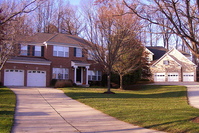Montgomery struggles to compete as both suburb and city
Montgomery County stands at a crossroads. Once-pristine suburban neighborhoods are starting to look worn out and suffer from disinvestment. Meanwhile, other areas are turning into urban enclaves, but they don’t provide all of the amenities that traditional city neighborhoods offer. It’s no longer the perfect suburb, but it’s not yet the ideal city either.
In the past year and a half, three of my friends from high school have gotten married. Both couples (two friends married each other) represent a demographic any place would kill for: twenty-something, educated, high-earning couples, eager to find a place where they can put down roots, at least for a few years.
Both couples like going out, seeing new places, and trying new things. And though we all grew up a few miles apart, both couples are moving out of Montgomery County, which no longer provides the lifestyle they want. One is moving to Howard County, the other to Alexandria.
The first couple just married in March and are already expecting a child. She works in Baltimore; he works at Fort Meade. Currently, they’re living with her parents in Calverton, but they’re looking for a house in Howard County. Why? It’s closer to their jobs, closer to shopping in Columbia, closer to Korean BBQ in Ellicott City.
Housing isn’t necessarily cheaper. After all, Howard is the fifth-wealthiest county in the United States. But though the house in our old neighborhood might cost the same as similar house in Columbia, the schools are likely better, the massive Columbia Association maintains the common areas, and Route 32 isn’t as congested as 29 or the Beltway (at least, not yet).
In short, Howard County has out-suburb’d Montgomery.
The other couple married last winter. He’s a graduate student at the University of Maryland; she works for an IT company in Old Town Alexandria. For the past two years, they lived in an apartment in Hillandale. Neither of them are keen on driving, so living in the shadow of the Beltway made it hard to get around. Much as they enjoyed hanging out in downtown Silver Spring, they were attracted to the wider array of bars, restaurants and shops in Alexandria, not to mention the ability to travel exclusively by foot, bike and transit.
Last month, they moved to an apartment in Carlyle, a new neighborhood being built around the Eisenhower Avenue Metro. They can literally see the trains from their window. A block away is a complex of shops, restaurants and a movie theater. One stop on the Yellow Line takes them to a really good Thai place on King Street, and one more stop brings them to their favorite taqueria in Del Ray.

Alexandria’s Carlyle neighborhood provides a stronger urban experience than anywhere in Montgomery County currently offers. Photo by faceless b on Flickr.
In this case, Alexandria has out-city’d Montgomery. You’d expect this, because Alexandria’s been a center of commerce for 262 years. But would you expect Montgomery to lose its much-treasured status as the “perfect suburbia” to Howard County?
Though my friends’ decisions on where to live was also influenced by proximity to work, a major consideration for anyone, the kinds of places they chose to live in say a lot about Montgomery County’s ability to compete for new and current residents.
Montgomery’s older suburban neighborhoods are losing out to newer communities on the fringe, which have more money to invest in schools and infrastructure and less to spend on maintenance and social issues. Meanwhile, urban centers like downtown Silver Spring and downtown Bethesda can’t always compete with their counterparts in Arlington, Alexandria and the District, which offer more activity, more housing choices, and more transportation options. Montgomery County will compete with both of these places for residents, businesses and tax dollars, and it has to compete with both if it’s going to survive.
It’s easy to demand the status quo. But let’s look at where the next generation is going. Are we creating a place where young professionals and new families want to live? And can we actually offer a compelling alternative to new suburbs and old cities alike? If we can find the answer, I’ve still got plenty of single friends looking for a place to live.

